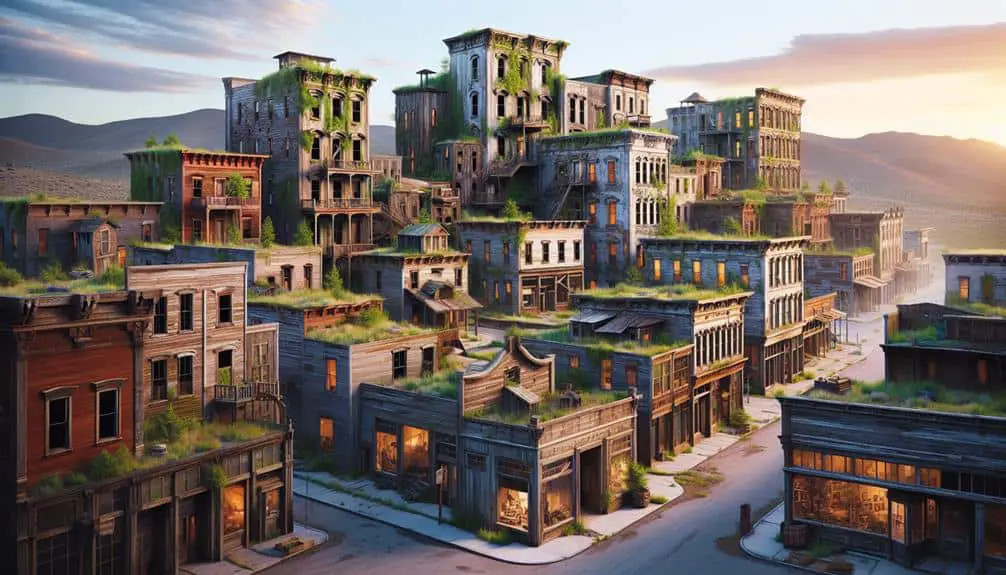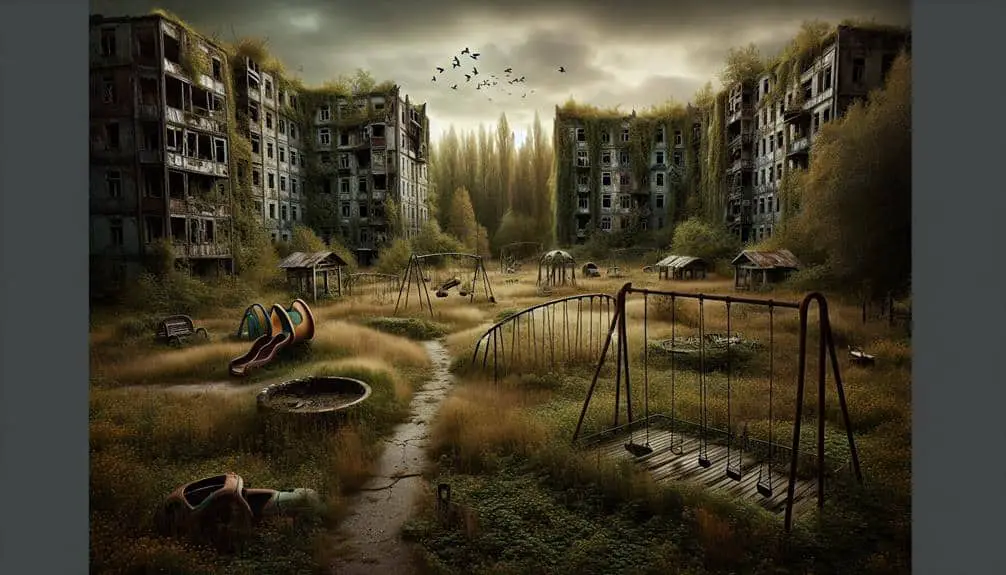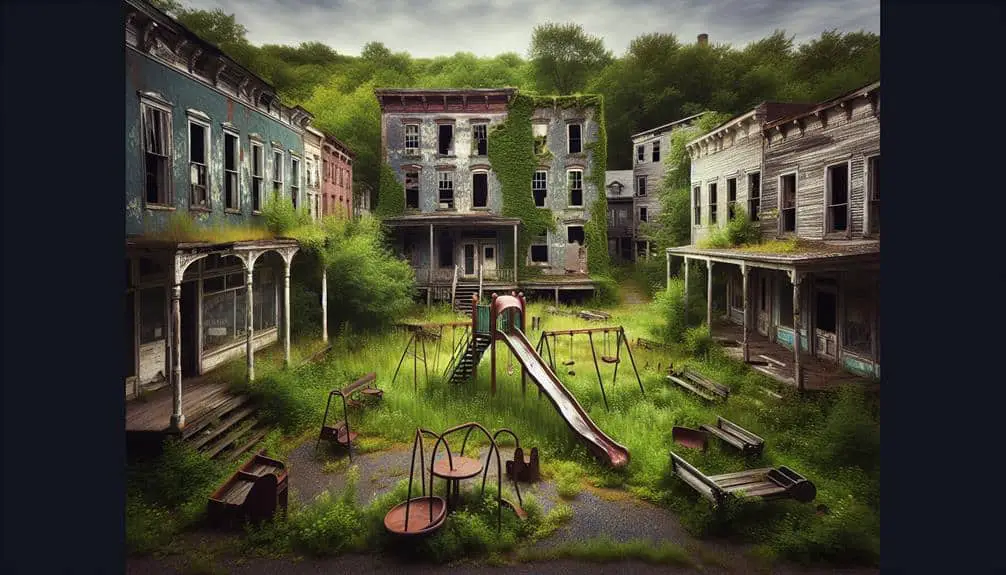To revive failed utopian communities in US ghost towns, embrace transformation. Learn from past mistakes to guide hopeful futures. Involve the community in innovative solutions. Prioritize financial sustainability and diverse perspectives. Collaboration and resilience are key. Preserve history through education and events. Create hubs of creativity and inclusion. Embrace sustainability and celebrate uniqueness. Consider sustainable practices for long-term viability. Your journey to reclaim forgotten dreams is a community-driven revival waiting to unfold.
Key Points
- Implement innovative sustainable practices for long-term viability.
- Foster active community engagement to overcome challenges.
- Seek creative funding sources for financial sustainability.
- Encourage collaborative efforts for effective revitalization.
- Embrace inclusivity and empowerment for community transformation.
Utopian Dreams Turned Ghostly Realities
Setting out on idealistic pursuits, utopian communities across the US transformed into haunting echoes of their once vibrant visions. Abandoned hopes now linger in the air, whispering of forgotten dreams and unrealized potentials. These communities, once brimming with optimism and aspirations for a better way of living, now stand as reminders of the fragility of such grand endeavors.
However, amidst the ruins and desolation, there's a glimmer of hope. From the ashes of these failed utopias rise the seeds of new beginnings. The ghosts of the past pave the way for a revival, where lessons learned from past mistakes guide the journey towards hopeful futures. The community spirit that initially brought people together still thrives, waiting to be reignited.
As you walk through these ghostly landscapes, envision not the decay and abandonment, but the possibilities that lie within these forgotten spaces. Embrace the challenges, learn from the past, and dare to dream of a future where utopian ideals can find sustainable roots once more.
Lessons Learned From Utopian Failures
Amidst the remnants of once hopeful utopian communities, the failures of the past offer valuable insights into the necessary adaptations and resilient approaches needed for future communal endeavors. When reflecting on these lessons learned, remember the importance of community engagement.
Here are some key takeaways:
- Flexibility is Key: Utopian visions must allow for adaptation and evolution over time.
- Inclusive Decision-Making: Involve all community members in the decision-making process to guarantee diverse perspectives are considered.
- Sustainable Practices: Prioritize environmentally friendly and sustainable practices to secure long-term viability.
- Resilience in Adversity: Build resilience to overcome challenges and setbacks that may arise.
- Continuous Learning: Embrace a culture of continuous learning and improvement to foster growth within the community.
Challenges of Rebuilding Utopian Ghost Towns
Traversing the intricate path of reviving Utopian ghost towns presents a myriad of challenges that demand innovative solutions and unwavering community dedication. To overcome these obstacles, active community engagement is essential. Encouraging residents to participate in decision-making processes fosters a sense of ownership and commitment, laying a strong foundation for sustainable growth. Financial sustainability is another critical factor. Developing creative funding sources, such as grants for heritage preservation or eco-tourism initiatives, can help breathe new life into these abandoned spaces.
In rebuilding Utopian ghost towns, remember that the strength of the community lies in unity. Collaborative efforts not only generate fresh ideas but also distribute the workload effectively. Embrace a bottom-up approach where every voice is heard and valued. By cultivating a culture of inclusivity and empowerment, you can inspire a shared vision that propels the community forward. Together, through community engagement and financial sustainability, you can transform these forgotten lands into vibrant, thriving hubs once more.
Preserving the History of Failed Utopias
Preserving the history of failed utopias requires a commitment to honoring the past while embracing the potential for future transformation within these abandoned communities. It's essential to engage with these spaces in a way that respects their historical significance while also fostering a sense of community ownership and empowerment.
Here are some ways you can contribute to preserving the legacy of failed utopias through historic preservation and community engagement:
- Create Educational Programs: Develop workshops and guided tours to educate visitors about the history and ideals of the utopian community.
- Organize Community Events: Host gatherings, festivals, and art exhibitions that celebrate the unique heritage of the failed utopia.
- Establish Preservation Funds: Raise money to support the restoration and maintenance of historic buildings within the ghost town.
- Encourage Local Participation: Involve residents of nearby towns in volunteer programs aimed at preserving the utopian community's history.
- Collaborate with Historians: Work with experts to document and archive the stories of former residents, ensuring their experiences aren't forgotten.
Strategies for Reviving Utopian Ideals
To reignite utopian ideals within abandoned communities, consider implementing innovative and community-driven strategies. Start by reimagining communities as hubs of creativity and collaboration. Encourage residents to participate in decision-making processes, fostering a sense of ownership and belonging. Embrace diversity and inclusivity, valuing the unique perspectives and contributions of each individual.
Fostering innovation is key to revitalizing failed utopian communities. Create spaces for experimentation and creativity, where new ideas can flourish. Support local entrepreneurs and artists, providing resources and opportunities for growth. Invest in sustainable practices that prioritize environmental conservation and community well-being.
Develop educational programs that empower residents to learn new skills and explore their passions. Cultivate a culture of lifelong learning and personal development. Encourage residents to share their knowledge and experiences, creating a vibrant exchange of ideas within the community.
Frequently Asked Questions
How Do Local Governments Typically Respond to Efforts to Revive Failed Utopian Communities in Ghost Towns?
Local governments often embrace local support for reviving failed utopian communities in ghost towns. They prioritize community engagement, seeking innovative solutions for sustainable development. Freedom-loving individuals find opportunities to shape the future of these areas.
Are There Any Legal Obstacles That Often Arise When Attempting to Rebuild and Repopulate a Utopian Ghost Town?
Legal challenges may include zoning restrictions, property disputes, and building codes. Community opposition might emerge due to fear of change or loss of historical identity. Overcoming these hurdles requires collaboration, compromise, and a shared vision.
What Role Do Existing Residents of Nearby Towns Play in the Revitalization of Failed Utopian Communities?
In revitalizing failed utopian communities, existing residents of nearby towns hold significant influence. Community engagement fosters unity and shared vision, accessing economic opportunities. Embrace collaboration, as the journey towards sustainable growth starts with collective empowerment.
How Do Environmental Factors, Such as Natural Disasters or Pollution, Impact the Feasibility of Reviving Utopian Ideals in Ghost Towns?
Consider how environmental factors like natural disasters and pollution affect the feasibility of reviving utopian ideals in ghost towns. Social dynamics and climate change play important roles in shaping the community's future and sustainability.
What Funding Sources Are Typically Utilized to Support the Restoration and Development of Failed Utopian Communities in the Us?
To support the restoration and development of failed utopian communities in the US, you can tap into a mix of funding sources. Community engagement and cultural preservation often drive grants, crowdfunding, partnerships, and government funding.



